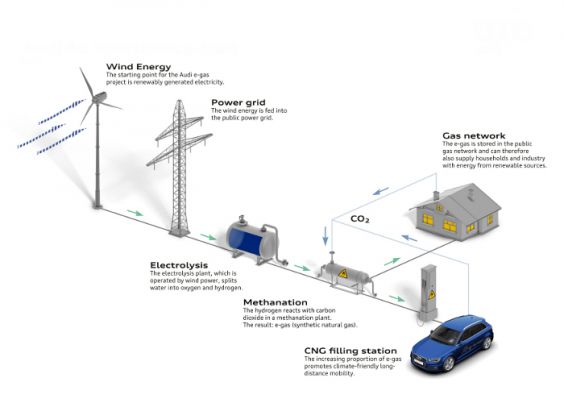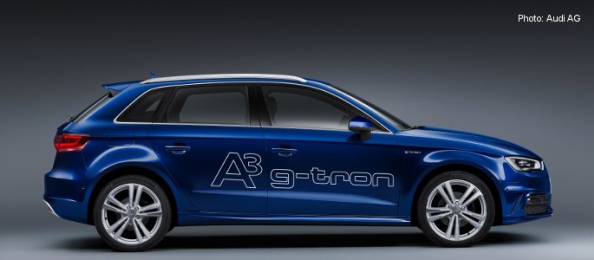Audi Future Energies – Balancing Business and Environmental Concerns
Sustainability is a guiding principle at AUDI AG. Sustainability helps us retain our competitive edge and economic efficiency as well as protect the environment and ensure a decent future for generations to come.
A primary objective concerns comprehensive CO2-neutral mobility. To this end, Audi is looking far beyond emissions from vehicle exhaust systems. Besides the actual usage phase, the company is also examining vehicle manufacturing and recycling processes as well as the upstream fuel supply chain that is increasingly gaining in importance.
Audi is the world’s first carmaker to become directly involved in the development and production of renewable fuels that do not rely on biomass. Audi is focusing on an entire range of drive technologies. Its fuels of tomorrow are Audi e-gas, Audi e-ethanol, Audi e-diesel, and Audi e-hydrogen.
| Initiator | Audi AG |
| Project start | - |
| Status | ongoing |
| Region | Worldwide |
| Contact person | Dr Peter F. Tropschuh |
| Awards | - |
Project benefit
- Strengthen low carbon cars
- Support "green mobility"
| Anti-Corruption | - |
| Business & Peace | - |
| Development | - |
| Environment | X |
| Financial Markets | - |
| Implementing UNGC Principles in your Corporate CSR Management | - |
| Human Rights | - |
| Labour Standards | - |
| Local Networks | - |
| Advocacy of global issues | X |
| Business opportunities in low income communities/countries | - |
| Project funding | - |
| Provision of goods | - |
| Provision of services/personal | - |
| Standards and guidelines development | - |
Audi e-gas
The first step is the Audi e-gas project: Audi is creating an entire chain of sustainable fuels. As a joint project of Audi and plant builder SolarFuel, the Audi e-gas plant in the northern German town of Werlte began operations in June 2013. It is the world’s first industrial facility to use CO2 and renewable electricity to generate a synthetic substitute for methane gas. The plant will run on renewable electricity generated via, for instance, wind or solar energy. The accelerating expansion of renewable energies means that energy sources subject to fluctuations play an increasingly larger role. In short, there is sometimes a surplus of electricity and at other times a shortage. With a rated input of around 6,000 kW, the plant will primarily use electricity from wind power whenever there is oversupply. That, in turn, will help solve a considerable problem associated with the sea change in energy: the storage of energy.
At the plant, renewable electricity will be used to split water via electrolysis into oxygen and hydrogen (Audi e-hydrogen), which will power the fuel-cell vehicles of tomorrow. A widespread hydrogen infrastructure does not yet exist, however. Audi uses another innovative process to solve this problem. The hydrogen is combined with CO₂ in the methanation facility downstream of the electrolysis plant to produce synthetic renewable methane gas – Audi e-gas. From there, it can then be fed into the natural gas network and stored there. It can later be tapped – anywhere, anytime.
The CO2 comes from waste gas emitted by a nearby biomethane plant operated by EWE, an energy provider. This biomethane plant runs on organic waste. The Audi e-gas facility uses the CO2 as a raw material for new fuel. Audi e-gas is thus a climate-neutral fuel – when combusted in the engine, exactly the same amount of CO2 is released as was previously bound at the e-gas plant.

Depending on the supply of electricity, the plant in Werlte is expected to produce some 1,000 metric tons of e-gas annually while chemically binding approximately 2,800 metric tons of CO2. These same 1,000 metric tons of Audi e-gas could power 1,500 Audi A3 Sportback g-tron vehicles for 15,000 kilometers (9,320.57 miles) per year in CO2-neutral driving.
CO2 tailpipe emissions for the Audi A3 g-tron are consequently less than 95 grams per km (152.89 g/mile). When the Audi A3 g-tron is powered by Audi e-gas, no more CO2 is released than was chemically bound in its production beforehand, creating a closed loop. Even when one includes in a comprehensive analysis the energy required to build the e-gas facility and wind turbines, CO2 emissions are still only 20 grams per km (32,18 g/mile).
The German energy industry could also benefit in the medium term from the concept of the Audi e-gas project, as it provides an answer to the unsolved question of how to store green power efficiently and independently of location. The potential of electricity-gas cogeneration to store large amounts of wind or even solar energy can provide powerful stimuli for the expansion of renewable energies.
Audi e-ethanol and Audi e-diesel
These projects address an old problem in search of a solution. Whenever conventional petroleum-based fuels are combusted, they release CO2 and pollute the atmosphere. Ethanol and diesel from renewable raw materials such as corn and rapeseed generally achieve a better environmental balance.
But these fuel sources compete with arable land for growing food. As such, they cannot constitute a long-term solution for our planet’s skyrocketing population.
The CO2-neutral mobility of tomorrow necessitates radically different fuels. Audi is therefore collaborating on just such a solution with the American company Joule. In a patented process, Joule manufactures fuels with the aid of special microorganisms in a highly scalable modular system (SolarConverter®): Audi e-diesel and Audi e-ethanol.
This process requires either wastewater or salt water; CO2; solar energy; and special single-celled microorganisms that are just thousandths of a millimeter in diameter. Just as plants do, these organisms carry out oxygenic photosynthesis. The experts at Joule have modified these microorganisms such that they produce ethanol or long-chain alkanes – important components of diesel fuel – directly from the CO2 and sunlight. The fuels are removed from the microorganisms, separated from the water, and cleaned. This technology is the basis for Audi e-diesel and Audi e-ethanol.
In short, e-ethanol is a product with the same chemical properties as bioethanol. But e-ethanol is far better, as no biomass is used in its production. This e-ethanol can be admixed with fossil fuel gasoline (e.g., E10) or, alternatively, can be used as the basis for E85 fuel (85% ethanol, 15% gasoline).
In addition to developing Audi e-ethanol, Audi is partnering with Joule to manufacture synthetic diesel fuel: Audi e-diesel. A considerable strength of Audi e-diesel will lie in its purity.
In contrast to petroleum-based diesel – a mixture of a great many hydrocarbon compounds – e-diesel is free of sulfur and aromatics. This fuel of tomorrow will also offer excellent ignition performance thanks to its high cetane number. And its chemical composition will permit unlimited blending with fossil fuel diesel.
Audi and Joule jointly built a demonstration facility in Hobbs, New Mexico – a barren region with lots of sunshine. This facility opened in September 2012. Audi e-ethanol was produced for the first time in transparent plastic tubes in early 2013 and manufacture of Audi e-diesel is expected to fellow in the next years. Efforts at the demonstration facility alone illustrate the clear superiority over conventional bioethanol. In line with forecasts, the yield of Audi e-ethanol is some 20 times greater! In addition, regions that are unsuitable for agriculture such as deserts could be utilized for energy production. Commercial production of the new fuels could begin within the next five years.
This project description was originally presented in the Global Compact International Yearbook 2013.
Dr. Peter F. Tropschuh is Head of Corporate Responsibility of Audi AG.
Elise Pham is an employee of Audi AG.
The Audi Group, comprising the two brands Audi and Lamborghini, has for many years been one of the world’s leading carmakers in the premium and supercar segment. Through the acquisition of DUCATI MOTOR HOLDING S.P.A., Bologna (Italy), and its subsidiaries, the Audi Group has moreover since July 2012 been able to offer its customers motorcycles built by one of the most successful manufacturers in that segment.
Write a comment about this page
Your comments are provided by your own free will and you take sole responsibility for any direct or indirect liability. In order to maintain the highest discussion quality, all comments will be reviewed by our editors. You hereby provide us with an irrevocable, unlimited, and global license for no consideration to use, reuse, delete or publish comments in accordance with our Community Guidelines.
About Us // Privacy Policy // Copyright Information // Legal Disclaimer // Contact
Copyright © 2012-2018 macondo publishing GmbH. All rights reserved.
The CSR Academy is an independent learning platform of the macondo publishing group.









